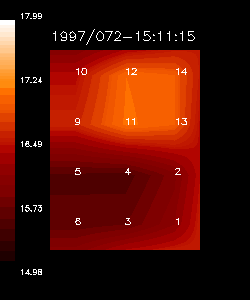Mission Analysis
Instrument Health and Safety

Temperature Gradients
- Optical path shifting – Because of the sensitive optics in SOLSTICE, the temperature gradients across the instrument were analyzed for any large discrepancies which could cause changes in these optics. This was done by using data from the 14 temperature monitors attached around SOLSTICE and the 4 internal temperature sensors to construct a temperature gradient display of the instrument.
- Gain Changes – Because the SOLSTICE detectors were sensitive to large temperature changes over a short time period, it wass important to watch for these periods and apply a temperature dependent correction. This occurred when the instrument was turned on after being off typically due to a spacecraft anomaly.
BOS/Slit failsafe logic – The SOLSTICE microprocessor was programmed with slit failsafe logic. This logic prevented the instrument from placing itself in an unsafe configuration with the slits in stellar position while the sun is up. This could cause large scale degradation in the detectors.
Loading errors – SOLSTICE was loaded daily between 2000-2400 UT with the next days experiments. Sometimes this load information became corrupted during transmission. When this occurred, it was possible for the instrument to configure itself in an unknown and undesirable state. To ensure proper configuration, SOLSTICE telemetered it’s memory contents at the rate of 254 bytes per second. These contents were verified with the expected contents to ensure proper execution of the planned experiments.
Autonomous Instrument Analysis
SOLSTICE ground software was configured to take advantage of near real time (15 minutes every orbit) and quick look (approximately 1.5 hours 3 times per day) data sets in order to automatically check the telemetry for out of limits conditions, verify memory and check for bad instrument configurations. When a bad state was detected, the software paged SOLSTICE personnel. The SOLSTICE analyst was then able to respond to the anomalies at any location and any time of day.
Spacecraft Operational Constraints
Power Availability – Although the spacecraft’s available power was a constraint on operations, SOLSTICE consumed less than 6 watts of power. This allowed SOLSTICE to remain operational in times of low power availability and when other instruments are turned off.
Experiment Validation
In order to ensure proper execution of other experiments, the success rate of the daily instrument loads was analyzed. This was accomplished with ground software which compared the planned experiment with what was actually executed. This prevented future anomalies, and provided ways to improve the amount of data taken.
Pointing Analysis
Accurate knowledge of the position of the target with respect to the SOLSTICE detectors, must be known. This allowed us to correctly adjust the data to account for the target’s position on the detectors. When tracking the sun, this position knowledge was obtained from a sun sensor mounted near the SOLSTICE instrument’s bore sight. During a stellar track we relied on spacecraft attitude and pointing information to calculate the pointing error rather than measuring it directly.
